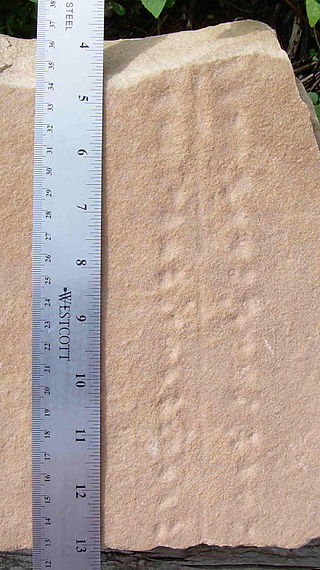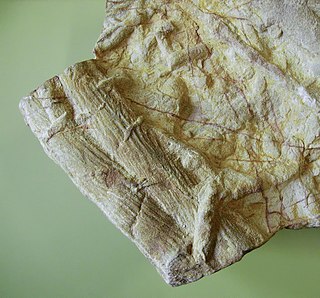
A trace fossil, also known as an ichnofossil, is a fossil record of biological activity by lifeforms but not the preserved remains of the organism itself. Trace fossils contrast with body fossils, which are the fossilized remains of parts of organisms' bodies, usually altered by later chemical activity or mineralization. The study of such trace fossils is ichnology and is the work of ichnologists.

Kimberella is an extinct genus of bilaterian known only from rocks of the Ediacaran period. The slug-like organism fed by scratching the microbial surface on which it dwelt in a manner similar to the gastropods, although its affinity with this group is contentious.

Protichnites is an ichnogenus of trace fossil consisting of the imprints made by the walking activity of certain arthropods. It consists of two rows of tracks and a medial furrow between the two rows. This furrow, which may be broken, set at an angle, and of varying width and depth, is thought to be the result of the tail region contacting the substrate.
Trace fossils are classified in various ways for different purposes. Traces can be classified taxonomically, ethologically, and toponomically, that is, according to their relationship to the surrounding sedimentary layers. Except in the rare cases where the original maker of a trace fossil can be identified with confidence, phylogenetic classification of trace fossils is an unreasonable proposition.

Odontogriphus is a genus of soft-bodied animals known from middle Cambrian Lagerstätte. Reaching as much as 12.5 centimetres (4.9 in) in length, Odontogriphus is a flat, oval bilaterian which apparently had a single muscular foot and a "shell" on its back that was moderately rigid but of a material unsuited to fossilization.

Climactichnites is an enigmatic, Cambrian fossil formed on or within sandy tidal flats around 510 million years ago. It has been interpreted in many different ways in the past, but is now thought to be a trace fossil of a slug-like organism that moved by crawling to on-shore surfaces, or near-shore, or burrowing into the sediment.

The Ediacaranbiota is a taxonomic period classification that consists of all life forms that were present on Earth during the Ediacaran Period. These were enigmatic tubular and frond-shaped, mostly sessile, organisms. Trace fossils of these organisms have been found worldwide, and represent the earliest known complex multicellular organisms. The term "Ediacara biota" has received criticism from some scientists due to its alleged inconsistency, arbitrary exclusion of certain fossils, and inability to be precisely defined.

Cruziana is a trace fossil consisting of elongate, bilobed, approximately bilaterally symmetrical burrows, usually preserved along bedding planes, with a sculpture of repeated striations that are mostly oblique to the long dimension. It is found in marine and freshwater sediments. It first appears in upper Fortunian rocks of northern Iran and northern Norway. Cruziana has been extensively studied because it has uses in biostratigraphy, and because the traces can reveal many aspects of their makers' behavior.

Diplichnites are arthropod trackways with two parallel rows of blunt to elongate, closely spaced tracks oriented approximately perpendicularly to the mid-line of the trackway. The term is more often used for the ichnofossils of this description; however, similar trackways from recent arthropods are sometimes given this name as well.

Palmichnium is an ichnofossil genus, interpreted as a eurypterid trackway. It has been found by many places around the world, such as Australia, Canada, United States and Wales.

Skolithos is a common trace fossil ichnogenus that is, or was originally, an approximately vertical cylindrical burrow with a distinct lining. It was produced globally by a variety of organisms, mostly in shallow marine environments, and appears as linear features in sedimentary rocks.

Rhizocorallium is an ichnogenus of burrow, the inclination of which is typically within 10° of the bedding planes of the sediment. These burrows can be very large, over a meter long in sediments that show good preservation, e.g. Jurassic rocks of the Yorkshire Coast, but the width is usually only up to 2 cm, restricted by the size of the organisms producing it. It is thought that they represent fodinichnia as the animal scoured the sediment for food.

Rusophycus is an ichnogenus of trace fossil allied to Cruziana. Rusophycus is the resting trace, recording the outline of the tracemaker; Cruziana is made when the organism moved. The sculpture of Rusophycus may reveal the approximate number of legs that the tracemaker had, although striations (scratchmarks) from a single leg may overlap or be repeated.

Diplocraterion is an ichnogenus describing vertical U-shaped burrows having a spreite between the two limbs of the U. The spreite of an individual Diplocraterion trace can be either protrusive or retrusive. Some ichnospecies have both types. The presence/absence of funnel-shaped openings should not be used as an ichnotaxobase due to the high probability that the upper portions of the trace may have been eroded away. Observation of the orientation of Diplocraterion in the field is frequently used to determine the way up of rock strata at outcrop.
Paleobuprestis is an ichnogenus of bioerosion trace fossils found in wood that are thought to have been produced by the larvae of beetles in the family Buprestidae. It was first described by American paleontologist and park naturalist Myrl V. Walker in 1938, based on channels found just under the bark of petrified logs from the Petrified Forest National Park in Arizona, dated to the Late Triassic epoch. He described two different species of these markings: Paleobuprestis maxima for channels with a diameter of about 10 mm, and Paleobuprestis minima for those with a diameter of only 2 mm. Paleobuprestis has since also been recorded from the Upper Jurassic Morrison Formation and the Upper Cretaceous Price River Formation. In 2013, a third ichnospecies, Paleobuprestis sudeticus, was described from the Viséan-aged Paprotnia Beds in the Polish Sudetes. In 2006, Charles L. Bellamy established a new genus-group name Archeobuprestis for P. maxima and P. minima, considering the name Paleobuprestis to be unavailable under the International Code of Zoological Nomenclature because it was described after 1930 without a type species designation in its original publication.

Chondrites is a trace fossil ichnogenus, preserved as small branching burrows of the same diameter that superficially resemble the roots of a plant. The origin of these structures is currently unknown. Chondrites is found in marine sediments from the Cambrian period of the Paleozoic onwards. It is especially common in sediments that were deposited in reduced-oxygen environments.

Kimberichnus is an ichnofossil associated with the early bilaterian Kimberella. It is known mostly from shallow marine Ediacaran sediments, often occurring alongside its producer. Kimberichnus often occurs in Russia and South Australia, where it is most abundant in the shape of multiple arcuate sets of ridges with fan-shaped arrangements.

Cheliceratichnus, meaning trace of a chelicerate arthropod, is an ichnogenus erected for a body imprint discovered in the Lower Jurassic East Berlin Formation of Holyoke, Massachusetts. The specimen is now housed at the Springfield Science Museum in Springfield, Massachusetts. Considering that only a single specimen was found, the ichnogenus is monospecific, with the species name lockleyi honoring paleontologist and ichnologist Martin Lockley. In trace fossil classification schemes based on behavior, the body imprint is considered a cubichnion, or resting trace. Cheliceratichnus lockleyi exhibits the tagma characteristic of arthropods, with the trace divided into anterior, central, and posterior regions. Dalman and Lucas (2015) interpreted these regions as imprints of the chelicerae, prosoma, and opisthosoma, respectively, of a chelicerate arthropod. Additionally, imprints of the animal's legs and telson were identified. These authors noted that, in general, the pattern of the trace was similar to the body plan of the Solifugae, or camel spiders, but also noted that the presence of a telson imprint rules out that group because these animals lack telsons. Consequently, they attributed the trace to a solifuge-like arthropod without being more committal on what made it. In addition to the body imprint, the animal produced a trackway, called Acanthichnus cursorius, leading away from the body imprint, which demonstrates that the animal was alive at the time its body imprinted the sediment.
Arcuites is an ichnofossil genus, interpreted as a eurypterid swimming trace. Traces produced by swimming eurypterids were described from the Silurian Williamsville Formation and Tonoloway Formation by Vrazo & Ciurca in 2017 as a new ichnogenus and ichnospecies, named Arcuites bertiensis.
Selenichnites is a Cambrian to Jurassic trace fossil that has been found on every continent. It consists of crescent-shaped impressions interpreted as resting or burrowing traces of Xiphosura.















